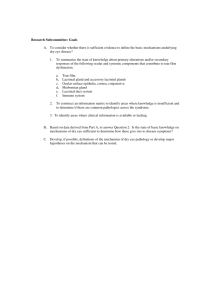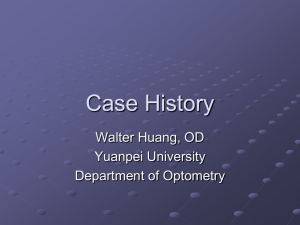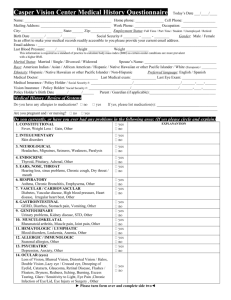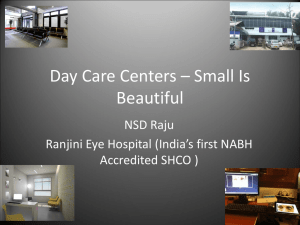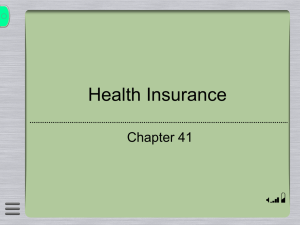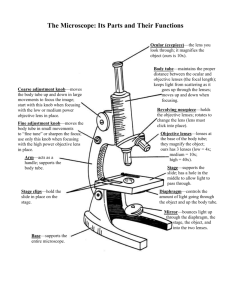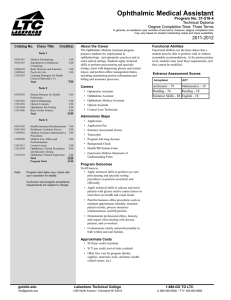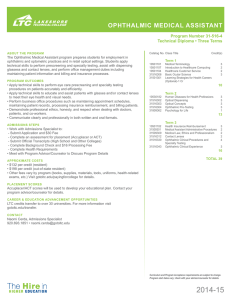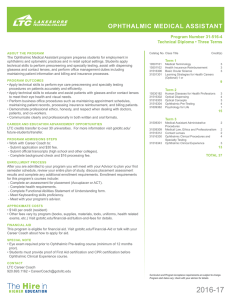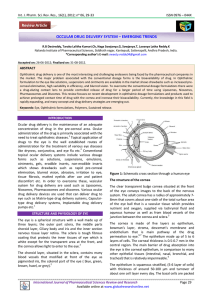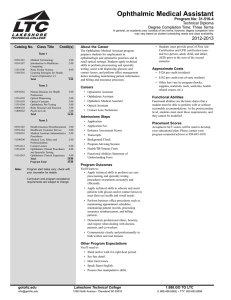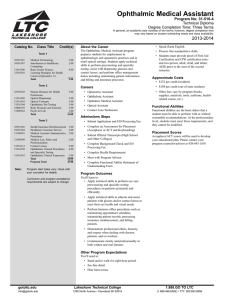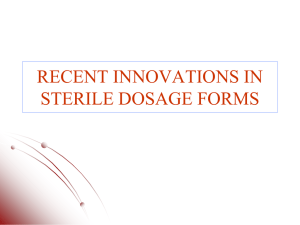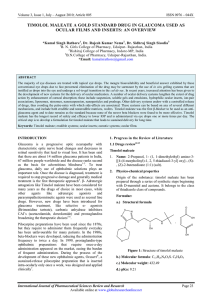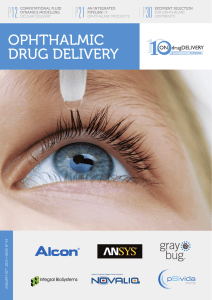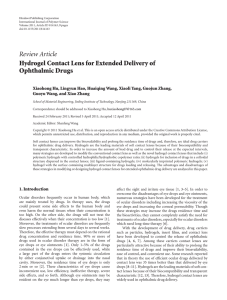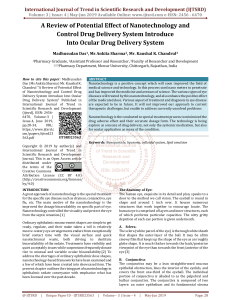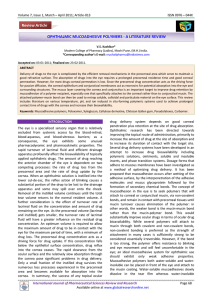SYLLABUS FOR DOTA (Diploma in Ophthalmic Technical Assistant)
advertisement
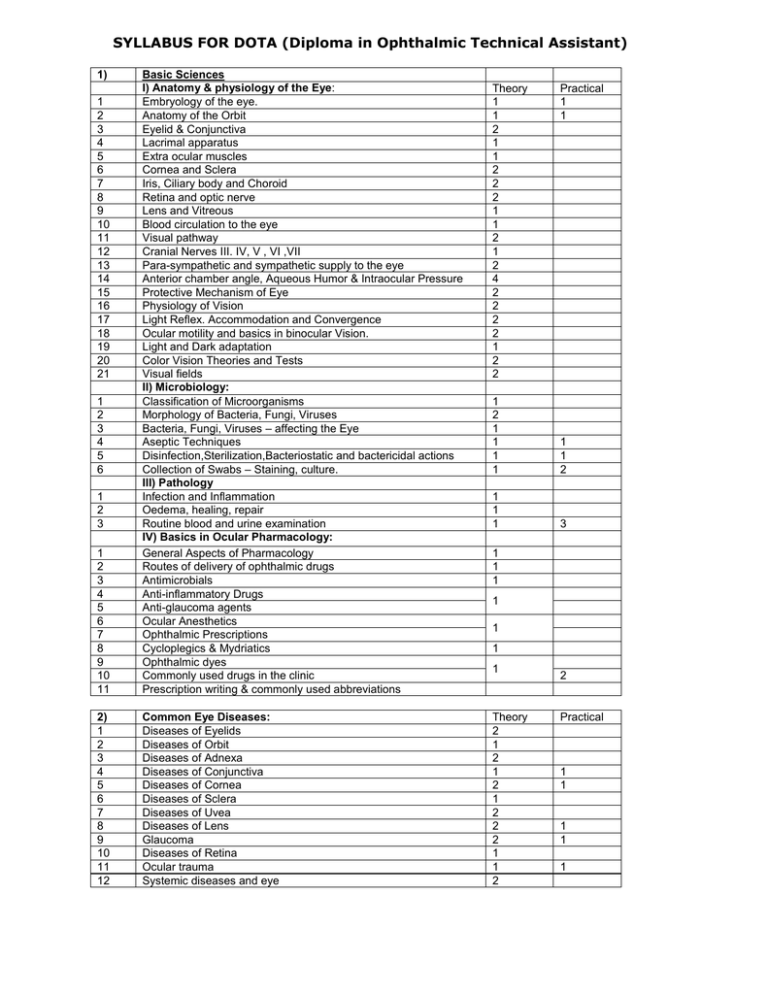
SYLLABUS FOR DOTA (Diploma in Ophthalmic Technical Assistant) 1) 1 2 3 4 5 6 7 8 9 10 11 Basic Sciences I) Anatomy & physiology of the Eye: Embryology of the eye. Anatomy of the Orbit Eyelid & Conjunctiva Lacrimal apparatus Extra ocular muscles Cornea and Sclera Iris, Ciliary body and Choroid Retina and optic nerve Lens and Vitreous Blood circulation to the eye Visual pathway Cranial Nerves III. IV, V , VI ,VII Para-sympathetic and sympathetic supply to the eye Anterior chamber angle, Aqueous Humor & Intraocular Pressure Protective Mechanism of Eye Physiology of Vision Light Reflex. Accommodation and Convergence Ocular motility and basics in binocular Vision. Light and Dark adaptation Color Vision Theories and Tests Visual fields II) Microbiology: Classification of Microorganisms Morphology of Bacteria, Fungi, Viruses Bacteria, Fungi, Viruses – affecting the Eye Aseptic Techniques Disinfection,Sterilization,Bacteriostatic and bactericidal actions Collection of Swabs – Staining, culture. III) Pathology Infection and Inflammation Oedema, healing, repair Routine blood and urine examination IV) Basics in Ocular Pharmacology: General Aspects of Pharmacology Routes of delivery of ophthalmic drugs Antimicrobials Anti-inflammatory Drugs Anti-glaucoma agents Ocular Anesthetics Ophthalmic Prescriptions Cycloplegics & Mydriatics Ophthalmic dyes Commonly used drugs in the clinic Prescription writing & commonly used abbreviations 2) 1 2 3 4 5 6 7 8 9 10 11 12 Common Eye Diseases: Diseases of Eyelids Diseases of Orbit Diseases of Adnexa Diseases of Conjunctiva Diseases of Cornea Diseases of Sclera Diseases of Uvea Diseases of Lens Glaucoma Diseases of Retina Ocular trauma Systemic diseases and eye 1 2 3 4 5 6 7 8 9 10 11 12 13 14 15 16 17 18 19 20 21 1 2 3 4 5 6 1 2 3 Theory 1 1 2 1 1 2 2 2 1 1 2 1 2 4 2 2 2 2 1 2 2 Practical 1 1 1 2 1 1 1 1 1 1 2 1 1 1 3 1 1 1 1 1 1 1 Theory 2 1 2 1 2 1 2 2 2 1 1 2 2 Practical 1 1 1 1 1 3) 1 2 3 4 5 6 7 8 9 10 Optics & Refraction (Total Lectures 30) Properties of light Principles of Reflection of light Principles of Refraction of light Lenses and their combinations Transposition of spectacle lenses Human eye as a optical system Visual Angles, Visual Acuity and Visual Axes Hypermetropia Myopia Astigmatism Theory 1 11 12 13 Anisometropia & Aniseikonia Accommodation and Convergence Commonly used optical & non optical devices for visually impaired 2 4 2 2 2 2 4) Functional English and Computer Fundamentals Theory Practical 1 2 3 4 5 6 1 2 3 4 5 5) 1 3 4 5 6 7 9 10 11 I) Computer Fundamentals Introduction to Computers Computer Hardware, Input Output devices, peripherals MS-Office (Overview) MS-Word MS-Excel MS-PowerPoint II) Functional English English used in communication – letter drafting Simple sentences Tenses Nouns,Verbs, adjectives Translation, Unseen passage Community Eye care Definition, Causes and magnitude of blindness and visual impairment, classification of childhood blindness, Comprehensive eye care Rehabilitation Eye banking and Death Counseling Organization of Health Services Principles of Primary Secondary tertiary care Introduction to occupational Health, hygiene and septic Prevention of ocular accidents OTA’s role as a primary health care professional Screening procedures in the fields Vision – Pediatrics Adults Phorias/Tropias/Amblyopias Optometric investigations and research for community Public Health Optometry–human resources, Epidemiology and projection Practical 1 1 10 2 1 2 2 2 10 2 2 2 2 1 1 2 2 2 2 Theory 2 Practical 2 2 1 1 2 2 1 1 1 2 3 1 2 3 1 2 4 2 6) OT management, equipment care and surgery assistance I) Operation Theatre assistance (Total Lectures 20) General aspects Sterilization and Disinfection Principles of sterilization Theatre set up Introduction to surgical instruments and operating room equipment Surgical Scrubbing Surgical Preparation and Draping Laying the trolley for minor surgery Fumigation Autoclaving/sterilization of instruments Cleaning of surgical instruments II) Care & maintenance of commonly used Ophthalmic equipments: Total Lectures 10 Torch light Trial frame Retinoscope Ophthalmoscope Slit lamp Microscope Phacoemulsification Applanation tonometer Vitrectomy Theory Theory Practical 1 4 4 2 2 2 2 1 1 2 2 1 1 2 2 4 4 2 2 2 2 1 2 2 1 1 2 3 4 5 6 7 8 Clinical Techniques and Dispensing Glasses I) Clinical Techniques – Visual acuity assessment Retinoscopy and steak retinoscopy Subjective Retinoscopy (Duchorome test & Jackson’s cross cylinder) Lensometry Slit lamp examination Applanation tonometry Direct Ophthalmoscopy Colour Vision Visual fields Syringing and lacrimal function tests Keratometry Pachymetry Exophthalmometry A Scan and IOL power calculation II) Dispensing Optics : Total Lectures 30 Spherical lenses Cylindrical lenses Parts of a frame Types of frames IPD measurement Bifocals and Multifocals Protective and Plastic lenses Fitting & grinding of lenses 1 2 4 2 2 4 1 1 1 1 1 8 8) 1 2 3 4 5 6 7 8 Secretarial Assistance Initial Patient Contact and Reception and Ethics Taking demographic information Preparation of case sheet Telephone & Office manners Opening & sending email Maintenance of medical records and their retrieval Patient counseling Helping the blind & visually impaired to navigate in the premises Theory 1 1 1 1 1 2 2 1 Practical 1 1 1 2 4 2 4 2 1 2 3 4 5 6 7 8 9 10 11 1 2 3 4 5 6 7 8 9 7) 1 2 3 4 5 6 7 8 9 10 11 12 13 14 1 2 1 2 2 2 2 2 2 2 2 1 1 1 1 1 1 1 2 1 Practical 4 4 4 2 1 2 4 4 2 4 2 1
